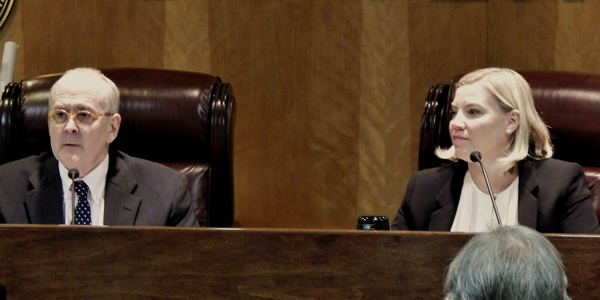By Tom Kleckner
AUSTIN, Texas — ERCOT’s energy-only market may not be broken, but stakeholders will discuss some fine-tuning at a Public Utility Commission workshop this week.
Market participants have complained about ERCOT’s use of reliability unit commitments, reliability-must-run contracts and other out-of-market actions. The Independent Market Monitor’s most recent State of the Market report made several recommendations on improving price formation. Texas regulators frequently discuss the need for real-time market co-optimization.

Hogan | © RTO Insider
And now comes an ERCOT market review by a pair of industry experts on competitive market design, William Hogan and Susan Pope. Hogan, professor of global energy policy at Harvard University’s John F. Kennedy School of Government, is credited with pioneering the design of modern energy-only markets. Pope, the managing director of FTI Consulting, is an expert on economics and price formation in electricity markets.
Their report, “Priorities for the Evolution of an Energy-Only Market in ERCOT,” was commissioned by Calpine and NRG Energy “to inform important policy decisions … to ensure the sustainability of the ERCOT competitive market” and filed with the commission in May.
On Thursday, Hogan and Pope will present their recommendations during a workshop hosted by PUC staff. They will be joined by Potomac Economics President David Patton, whose firm provides market monitoring services for ERCOT, ISO-NE, MISO and NYISO. All three will participate in a Q&A session with staff, commissioners and other interested parties, while ERCOT staff and the Monitor will discuss progress on the commission’s market co-optimization and price-formation dockets (41837 and 47199).
“Our energy-only market is doing pretty well,” PUCT Commissioner Ken Anderson said during the commission’s most recent open meeting in July. “There are issues that need to be improved or corrected. There are always tweaks.
“I’d like ERCOT and the IMM to be able to comment on the cost estimate and time implementation,” Anderson said. “[The IMM has] been pushing real-time co-optimization in the time I’ve been here. I’ve been concerned about the price estimate and the time it would take to implement.”
ERCOT’s preliminary estimate is that it will take at least $40 million and up to five years to implement co-optimization. Staff has also reported to the PUC the numerous actions it has already taken or will to address price formation.
Anderson has called Hogan and Pope’s report a “very interesting read” and “largely complimentary” to the ERCOT market.
“It does point out the challenges resulting from natural gas [generation] and the dramatic expansion of intermittent renewable resources,” Anderson said. “At the heart of the report is a recognition that our market is premised foundationally on proper scarcity pricing.”

PUCT Commissioners Anderson (left) and Marquez | © RTO Insider
The report calls ERCOT’s commitment to price formation as the “single most important principle to get right in the energy-only market structure.”
“However,” Hogan and Pope write, “the existence and emergence of numerous factors that distort price formation” threaten the ERCOT competitive market “if left unaddressed.”
Hogan and Pope’s review was primarily meant to assess ERCOT’s operating reserve demand curve (ORDC), a PUC-ordered price adder designed to reflect the value of reserves. They concluded that while the ORDC has operated “within the context of its basic design,” it has not been “severely tested,” and scarcity price formation is being “adversely influenced by factors not contemplated by the ORDC.”
Anderson has pointed to an August 2015 event, when “the ORDC adder did not seem to reflect appropriately” a reduction in physical responsive capacity (PRC) — online generation able to quickly respond to system disturbance. He questioned whether the inputs used to calculate the loss-of-load probability should be re-evaluated. (See ERCOT: No Consensus on Operating Reserve Changes.)
During that event, ERCOT operators deployed non-spinning reserves as PRC dropped to 2,371 MW. However, real-time online reserve capacity was 3,629 MW, and wholesale prices reflected that availability.
Hogan and Pope also say other improvements can be made to ERCOT’s market “to better maintain private market response to energy prices as the driver of resource investment, maintenance expenditure and retirement decisions.”
The energy-only market was supposed to drive investment in generation, but the availability of cheap natural gas and renewable resources has made new coal and nuclear plants uneconomic.
“The stress of these forces has exposed areas where there is a need for adjustments to pricing rules and policies within ERCOT,” Hogan and Pope write.
Their report focuses on three recommendations:
- Improving the ORDC calculation to address “the reliability impacts of changes in the generation supply mix and the price impacts of reliability deployments,” and considering the use of the marginal cost of transmission losses in dispatch and pricing.
- Changes to mitigated offer prices and pricing of transmission constraints to properly set prices when using RUCs or other reliability actions to relieve transmission constraints. Regionwide and local ORDCs should be included in co‐optimized energy and reserves dispatch.
- Considering alternatives to socialized transmission planning, “which, by building new transmission in advance of scarcity developing, fails to provide the opportunity for markets to respond.”
Luminant, the largest generator in the state, opposes the use of marginal losses, saying pricing and dispatch based on marginal losses is inconsistent with transmission-cost policies established by Senate Bill 7, Texas’ 1999 deregulation legislation. Amanda Frazier, the company’s representative to ERCOT’s Technical Advisory Committee, said using the marginal cost of transmission losses could result “in a significant disruption to the market by redistributing revenues from generators in the West and North to generators in Houston.”
Luminant’s opposition is just emblematic of the shareholder discussions taking place within ERCOT.
“Stakeholders have been addressing this, I think, a little too slowly,” Anderson said. “I think we’re probably going to need to pick this up to get the ball moving a little faster.”




